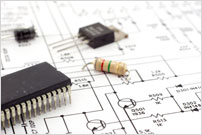November 2013 Issue
A summary of this month's contents.
CLASSiC-D Amplifier (Part 1) - World's first DIY high-power high-performance Class-D Amplifier: rated 250W into 4 Ohms / 150W into 8 ohms!
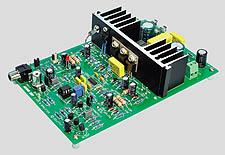
After many years of research and trials we are proud to present the world's first DIY Class-D (switching) high power amplifier. It offers high power, very low harmonic distortion and is very quiet. In bridged mode it can go further still and offer up to 500W into 8 ohms. Current, voltage and temperature protection and optional speaker protector module are included.
A highly-detailed artice describes the specification and principles of operation in full, with construction following next month.
Teach-In 2014 - the Raspberry Pi (Part 2)
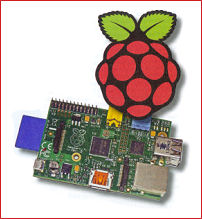 The Raspberry Pi is a British-designed single board computer that has taken the world by storm with over 1.5 million units sold.
The Raspberry Pi is a British-designed single board computer that has taken the world by storm with over 1.5 million units sold.
The credit-card size device has a USB port for mouse/ keyboard / wi-fi adaptor etc. and an HDMI interface for displaying on TV. In Part 2 readers take a tour of the Raspberry Pi's graphical user interface (GUI) and applications that are supplied with the Pi. Also we look at how the Pi general purpose input/ output GPIO interface works, and of course some practical experiments are described.
There's lots to see and do so make a start with the Raspberry Pi and read Teach-In 2014!
LED Musicolour (Part 2)
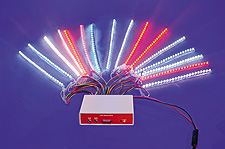
This new sound-to-light display can power 32 or even 64 sets of LEDs in rythm to sound. Use audio input from any line source or play .wav files on the built-in SD card, for a sophisticated self-contained sound & light controller that you'll be thrilled to use. 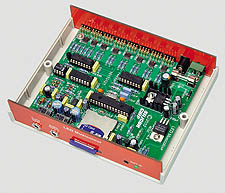
Perfect for Christmas lighting effects, store displays, parties and more besides. Part 2 this month describes the construction, testing and use of the LED Musicolour.
Mains Timer for fans or lights
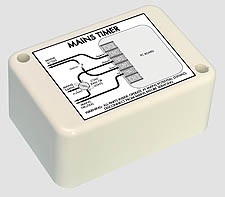
This simple circuit provides a turn-off delay for a 230V light or extractor fan. It can be used to run a bathroom fan for a set period and turn it off after the switch has been turned off, or employ a pushbutton instead to turn a light or outside driveway light on for a specific time.
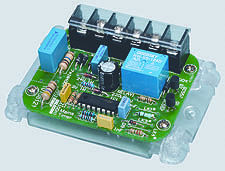
Delays of 1, 5, 10 and 20 minutes can be selected using links and details showing how periods up to an hour can be configured are included.
![]() PLEASE TAKE NOTE
PLEASE TAKE NOTE
It has since come to light that the labels for CON1 were switched around on Fig.3 (p.32). This inconsistency was due to some circuit schematic changes.
CON1 should be labelled, from top to bottom:
1 - Lperm
2 - Lload
3- Lsw
4 - N.
![]() ERRATUM
ERRATUM
Do not wire the unit up as shown in Fig.1(c) on page 31, with a load from the ‘Lsw' terminal to Neutral. This will destroy the unit. If you need to wire up a fan and light, connect them in parallel between the ‘Lload' terminal and Neutral.
EPE apologises for these errors.
Recycle It! - Cheap Power Supply
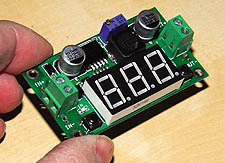
Our scavenging specialist shows how to build a two-amp variable d.c. power supply for under a fiver! Using a prebuilt LM2596-based module with digital voltmeter built in, it's easy to add the specified mains adaptor and assemble a complete mini PSU for yourself. Our experts explains everything you need to know.
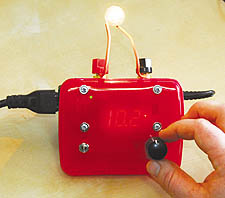
Our designer used a translucent plastic box to hold everything and the digital display is clearly visible in ordinary conditions. A great way to make a useful piece of test equipment for your experiments.
Also in this issue:
- Practically Speaking - PCB soldering basics are described in our hands-on workshop column.
- Circuit Surgery - rotary encoders and quadrature signal changes.
- Techno Talk - emerging trends in indoor location technologies.
- Net Work - the Internet column checks out the HTC One Android phone to see what it can do on a home area network.
You can order a printed copy of EPE for delivery to your door (worldwide), or try the PDF Version (needs Adobe Reader for Windows), or the Pocketmags for your mobile device. Subscribe now!
Source code file 1113.zip (Updated 9/4/2014)
Cheap Power Supply
www.ebay.co.uk - search for 'LM2596'
![]() PLEASE TAKE NOTE
PLEASE TAKE NOTE
MAINS TIMER FOR LIGHTS AND FANS
It has since come to light that the labels for CON1 were switched around on Fig.3 (p.32). This inconsistency was due to some circuit schematic changes.
CON1 should be labelled, from top to bottom:
1 - Lperm
2 - Lload
3 - Lsw
4 - N.
![]() ERRATUM
ERRATUM
Do not wire the unit up as shown in Fig.1(c) on page 31, with a load from the ‘Lsw' terminal to Neutral. This will destroy the unit. If you need to wire up a fan and light, connect them in parallel between the ‘Lload' terminal (CON1/ 2) and Neutral (CON1/ 4).
EPE apologises for these errors.
PCB artwork
As from July 2013 issue PCB artwork is available free to subscribers only.
Non-subscribers may purchase artwork files for a nominal sum. Please contact our Orders Dept for information or to place an order.
EPE Printed Circuit Boards
We can supply ready-made printed circuit boards (8-digit order codes) to the original design specification via mail order or from our Online Shop.

